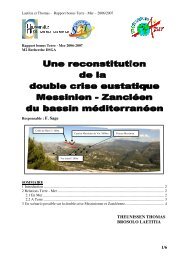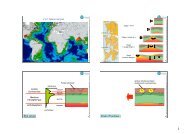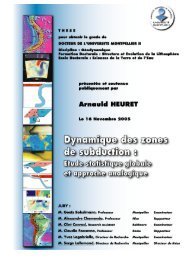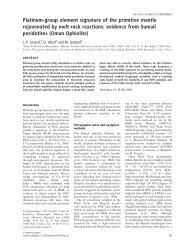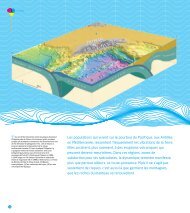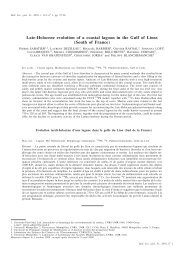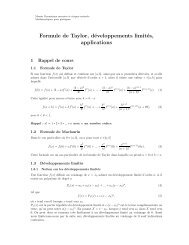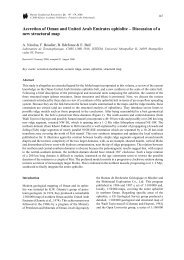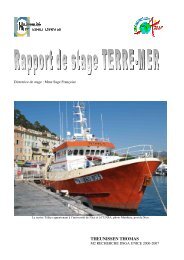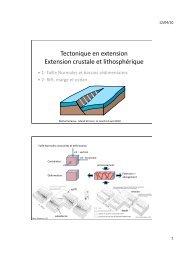Géochronologie U-Pb par ablation laser et ICP-MS (LA-ICP-MS ...
Géochronologie U-Pb par ablation laser et ICP-MS (LA-ICP-MS ...
Géochronologie U-Pb par ablation laser et ICP-MS (LA-ICP-MS ...
You also want an ePaper? Increase the reach of your titles
YUMPU automatically turns print PDFs into web optimized ePapers that Google loves.
Ofioliti, 2006, 31 (2), 189-206 189<br />
PETROGENESIS OF MANTLE PERIDOTITES<br />
FROM THE IZU-BONIN-MARIANA (IBM) FOREARC<br />
Alberto Zan<strong>et</strong>ti* ,! , Massimo D’Antonio**, Piera Spadea***, Nicola Raffone°, Riccardo Vannucci* , °<br />
and Olivier Bruguier°°<br />
* CNR-Istituto di Geoscienze e Georisorse, Sezione di Pavia, Italy.<br />
** Di<strong>par</strong>timento di Scienze della Terra, Università Federico II, Napoli, Italy.<br />
*** Di<strong>par</strong>timento di Georisorse e Territorio, Università di Udine, Italy.<br />
° Di<strong>par</strong>timento di Scienze della Terra, Università di Pavia, Italy.<br />
°° ISTEEM-CNRS, Montpellier, France.<br />
! Corresponding author, e-mail: zan<strong>et</strong>ti@crystal.unipv.it.<br />
Keywords: Forearc mantle peridotite, supra-subduction zone, <strong>par</strong>tial melting, porous flow reaction, Izu-Bonin-Mariana.<br />
ABSTRACT<br />
Serpentinised spinel harzburgites to orthopyroxene-rich spinel dunites recovered during the Ocean Drilling Program (ODP) Leg 195 on top of the South<br />
Chamorro Seamount (southern sector of the Mariana forearc, West Pacific Ocean), along with additional spinel harzburgites from Conical and Torishima<br />
Seamounts (northern Mariana and Izu-Bonin forearc, respectively), previously collected during the ODP Leg 125, have been investigated to shed light on the<br />
nature and evolution of forearc mantle in the intra-oceanic supra-subduction environment.<br />
All the samples show a marked h<strong>et</strong>erogeneity in terms of p<strong>et</strong>rographic, mineralogical and geochemical features that suggests a complex, multistage evolution<br />
involving, at variable extent, <strong>par</strong>tial melting, reactive porous flow melt migration and subsolidus m<strong>et</strong>amorphic re-equilibration under decreasing T and<br />
open system conditions. Geochemical evidence of the interaction b<strong>et</strong>ween peridotites and various melts/fluids is the ubiquitous enrichment in highly incompatible<br />
elements, such as Large Ion Lithophile Elements (LILE).<br />
As for the high-T evolution of these peridotites, a three-stages-model is proposed, involving: 1) a former depl<strong>et</strong>ion event, during which the IBM forearc<br />
peridotites experienced 20-25% polybaric fractional melting during adiabatic upwelling; 2) a second depl<strong>et</strong>ion event characterised by a marked impoverishment<br />
in modal orthopyroxene, related to the upraise migration of ultra-depl<strong>et</strong>ed melts; 3) a late interaction b<strong>et</strong>ween a relatively small volume of residual melts<br />
and the refractory mantle sequence. Oxidation state of the mantle minerals meanly decreases from north (Torishima Seamount) to south (South Chamorro),<br />
according to significant different contributions coming from the subducted Pacific Plate. In <strong>par</strong>ticular, the absence of a marked oxidation in South Chamorro<br />
peridotites suggests that the percolating melts during Stage 2 had not significant slab-derived component.<br />
This observation lead us to conclude that a thermal anomaly in the western Pacific mantle rather than the injection of hydrous components must be the<br />
“engine” d<strong>et</strong>ermining the extreme depl<strong>et</strong>ion of the oceanic forearc peridotites and the arc formation. In this frame, it is proposed that IBM peridotites during<br />
Stage 1 underwent decompression <strong>par</strong>tial melting and contributed to arc volcanism as actual mantle source. Successively, they were emplaced at relatively<br />
shallow levels (Stage 2), constituting the top of a strongly refractory mantle column and being percolated by melts produced by plumbing sources of the arc<br />
volcanism.<br />
INTRODUCTION<br />
Intra-oceanic Supra-Subduction Zones (SSZ) are characterised<br />
by an extreme complexity in terms of geological and<br />
tectonic environments. They can comprise trenches, volcanic<br />
arcs, spreading centres, fracture zones, mud<br />
seamounts in the forearc, backarc and forearc basins, whose<br />
spatial relationships may rapidly change with time. Consistently,<br />
mantle peridotites recovered from this realm commonly<br />
record a multistage evolution that can furnish valuable<br />
information for unravelling the p<strong>et</strong>rologic and geodynamic<br />
processes underwent by different SSZ regions (e.g.<br />
Pearce <strong>et</strong> al., 2000, and references therein).<br />
The mantle peridotites recovered from forearc regions<br />
are of <strong>par</strong>ticular interest to place constraints on the origin<br />
and the early evolution of SSZ. Since Bonatti and Michael<br />
(1989), it has been assessed that forearc peridotites are more<br />
refractory than abyssal peridotites far from trenches. This<br />
distinctive character was firstly interpr<strong>et</strong>ed as the evidence<br />
of additional <strong>par</strong>tial melting episodes in mantle wedge systems<br />
due to introduction of water released by subducting<br />
slabs and possibly related to arc tholeiites and/or boninites<br />
generation. The relevance of this process was fundamentally<br />
recognised also by successive works focalised on the forearc<br />
peridotites from the Izu-Bonin-Mariana (Ishii <strong>et</strong> al., 1992;<br />
Parkinson <strong>et</strong> al., 1992; Parkinson and Pearce, 1998) and<br />
South Sandwich areas (Pearce <strong>et</strong> al., 2000).<br />
However, the importance of the percolation of exotic<br />
melt/fluid after <strong>par</strong>tial melting episodes in modifying the<br />
mineralogical, p<strong>et</strong>rographic and geochemical features of<br />
these peridotites was progressively highlighted.<br />
Pearce <strong>et</strong> al. (2000) concluded that a range of types of<br />
mantle can occur in forearc s<strong>et</strong>tings: MORB lithosphere interacting<br />
with arc magma (Mariana forearc), transitional<br />
lithosphere interacting with arc magma (South Sandwich<br />
forearc), slightly depl<strong>et</strong>ed mantle interacting with back-arc<br />
basin magma (South Sandwich Trench-Fracture Zone intersection),<br />
and arc lithosphere interacting with arc magma<br />
(Izu-Bonin forearc).<br />
More recent hypotheses on the genesis of the SSZ magmatism<br />
(and, in <strong>par</strong>ticular, of boninites) and of the geological<br />
conditions allowing for the ons<strong>et</strong> of intra-oceanic subduction<br />
invoke a positive thermal anomaly of the mantle related<br />
to plume upwelling and/or asthenosphere flow<br />
(Macpherson and Hall, 2001; Flower <strong>et</strong> al., 2001; Niu <strong>et</strong> al.,<br />
2003).<br />
A new opportunity to document the p<strong>et</strong>rologic features of<br />
forearc peridotites has been provided by drilling at Site<br />
1200 during Ocean Drilling Program (ODP) Leg 195 (Shipboard<br />
Scientific Party, 2002). In this Site, the top of the



